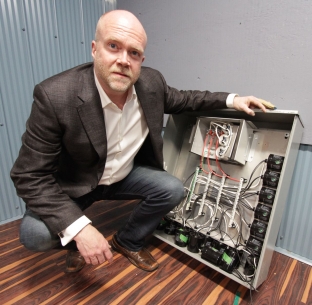By David Dodge and Duncan Kinney (http://www.greenenergyfutures.ca/episode/industrial-energy-efficiency)
Put your hand on the radiator in our office’s parkade stairwells and you’re liable to get burned, whether it’s January or July.
It’s energy waste and it lines up with the U.S. Department of Energy estimates that an average of 30 per cent of the energy that is paid for is wasted. High peak demand, inefficient lights, wrong-sized motors and a whole host of other energy wasting systems makes energy efficiency in the commercial and industrial sectors a $750 billion dollar opportunity.
This is not news. Energy consultants have been helping companies reduce operator error, identifying energy wasting systems and proposing energy efficient retrofits for a while now. But what is new is the next generation of energy efficiency companies who are using super smart meters and big data to identify, measure and wrestle energy sucking systems into submission.
Big data and common sense

David Gray is the CEO of Aim Energy Pros. He stands next to his company’s proprietary smart meter. Photo by David Dodge of Green Energy Futures.
We found two startups that are bringing this new approach to energy efficiency to bear. Aim Energy Pros is based in Edmonton, Alberta, and they’ve developed their own metering system that combines super-high-resolution data on energy use, circuit by circuit, with their own analytics suite. Circuit Meter out of Toronto sells and installs permanent high resolution monitoring in commercial and industrial operations as well as an online dashboard and monitoring system that helps find energy waste.
You may have heard of smart meters. The meters that these companies deploy are more like genius meters. They each have a mix of proprietary hardware and software that allows them to generate and analyze data on energy at a very granular level. But it’s not just big data; there’s a heaping spoonful of common sense added to the mix as well.
“They had one of those Star Trek doors that opens when people get close to it,” says David Gray, the CEO of Aim Energy Pros about one of his clients. “We set up a camera to see how often it was being triggered and found that it was running 50 to 60 times an hour just with people going by to the washroom. And so, there’s this thing, just opening up and letting heat out at 30 below, when really, the best solution would be just a set of doors that people open when they want to go in and out.”
Paul Mertes, the CEO of Circuit Meter has had similar experiences. “It never fails to happen that when a client puts in one of these systems that they find things that they weren’t expecting. It’s really a case of you don’t know what you don’t know or the other one, you can’t manage what you can’t measure.”
Mertes found an underground snow melt system that was turned on in July, emergency exit stairwells that were being heated in May and air-conditioning systems running in January, February and March.
The low-hanging fruit is still upgrading your lighting to LEDs, but these new high tech energy detectives collect super nerdy energy use data like voltage, current, power factor, peak demand and real and apparent power.
Smooth out your peak demand and save

Paul Mertes is the CEO of Circuit Meter. Photo courtesy of Circuit Meter.
Industrial and commercial energy users can save up to 30 per cent on their electricity costs by lowering their peak demand. In many jurisdictions there is a charge associated with the biggest spike on your electricity bill, and that charge sticks with you for the entire year.
Gray discovered that one industrial customer hit peak demand right after lunch when all equipment was turned on at the same time. By simply staggering start-up times, they were able to reduce the client’s peak demand charge and save $36,000 a year.
This kind of high-resolution monitoring also helps customers solve power factor (the ratio of power being used to power wasted) problems, a common complaint for commercial and industrial operations with lots of motors.
Companies work very hard to reduce inputs costs, save on shipping and keep a handle on labour costs, but no one should overlook to opportunity to save up to 30 per cent on their energy costs.
“Unless you have a problem with productivity or comfort you don’t really have a clue how or where to look to find your savings. What this (energy monitoring) does is shine a light on all of the uses, it allows you to investigate everything and compare it against standards. From there you can go into a mode of active management so it makes your energy visible,” says Mertes.
The fixes and upgrades that Circuit Meter and Aim Energy Pros recommend come with fast paybacks and high internal returns on investment. And while the business models and the details of these two companies differ, scaling up industrial and commercial energy efficiency will be key to a lower carbon future. Saving energy, saving money and saving carbon is just good business sense.
